
Research
Malicious npm Packages Impersonate Flashbots SDKs, Targeting Ethereum Wallet Credentials
Four npm packages disguised as cryptographic tools steal developer credentials and send them to attacker-controlled Telegram infrastructure.
@thevsstech/react-native-echarts-wrapper
Advanced tools
Screenshots • How To Use • Authors

The fact that the charting framework purely runs in a webview makes it very stable to upcomming React-Native versions. On the other hand it is not easy to make a two way data communication between the chart (running in the webview Javascript thread) and the React-Native Javascript thread. With this library you can even build the more complex chart options of echarts. You can inject custom javascript code within the webview which allows you to access the chart api (detect taps, selections etc...)



$ yarn add react-native-echarts-wrapper
Make sure you installed react-native-webview
| Version | Expo | React-Native |
|---|---|---|
| 2.x.x | >= 0.33 | >= 0.58 |
| 1.x.x | / | >= 0.56 |
| Name | Type | Example | Description |
|---|---|---|---|
| option | object | take a look at the examples | Allows you to set the chart configuration (https://ecomfe.github.io/echarts-examples/public/index.html). Never access anything related to your React-Native Javascript code within the options object. It won't work! Take a look at onData and sendData |
| customTemplatePath | string | file:///android_assets/index.html | Use this property if you want to tell echarts where to look for a custom html template. You can use RNFS to get the directory path for Android/iOS. |
| additionalCode | string | alert('hello world'); | Allows you to inject javascript code in the webview. It is used to access the echarts api to create more complex charts (e.G. callback on chart tap). Take a look at More complex example |
| backgroundColor | string | rgba(255,101,80,0.4), red, #4287f5 | Set the background color of the chart |
| Name | Example | Description |
|---|---|---|
| setOption | this.chart.setOption(option); | Allows you to set a chart configuration dyanmically (e.g. after initial setup with option prop). Take a look at Dynamic loading example |
| getOption | this.chart.getOption((data) => console.log(data)); | Allows you to get the current option of a chart instance. First parameter is the result-callback. If you don't pass a second parameter the result-callback will be triggered with all option properties. Second parameter is an array of the e-charts-option-properties (e.g. ['dataZoom', 'series']) you want to get. Take a look at Dynamic loading example |
| clear | this.chart.clear(); | Allows you to clear the chart. Take a look at More complex example |
| onData | <ECharts onData={this.onData} /> | This is the only way to receive data from the chart. It is called with the data provided by sendData (Webview functions). |
| setBackgroundColor | this.chart.setBackgroundColor('#ecf542'); | Allows you to set the background color of the chart. |
These functions can be called from code injected with additionalCode or within the echarts option.
| Name | Example | Description |
|---|---|---|
| sendData | sendData('Hello World') | With this function you can communicate with React Native. Attention you can only send strings over to React-Native. sendData('Hello World') will call onData on the React Native side. Take a look at More complex example |
| Name | Example | Description |
|---|---|---|
| chart | chart.on(....) | Allows you to access the echarts api (https://ecomfe.github.io/echarts-doc/public/en/api.html#echartsInstance). Take a look at More complex example |
import React, { Component } from "react";
import { StyleSheet, View } from "react-native";
import { ECharts } from "react-native-echarts-wrapper";
export default class App extends Component {
option = {
xAxis: {
type: "category",
data: ["Mon", "Tue", "Wed", "Thu", "Fri", "Sat", "Sun"]
},
yAxis: {
type: "value"
},
series: [
{
data: [820, 932, 901, 934, 1290, 1330, 1320],
type: "line"
}
]
};
render() {
return (
<View style={styles.chartContainer}>
<ECharts
option={this.option}
backgroundColor="rgba(93, 169, 81, 0.3)"
/>
</View>
);
}
}
const styles = StyleSheet.create({
chartContainer: {
flex: 1
}
});
import React, { Component } from "react";
import { StyleSheet, SafeAreaView, Button } from "react-native";
import { ECharts } from "react-native-echarts-wrapper";
export default class App extends Component {
option = {
xAxis: {
type: "category",
data: ["Mon", "Tue", "Wed", "Thu", "Fri", "Sat", "Sun"]
},
yAxis: {
type: "value"
},
series: [
{
data: [820, 932, 901, 934, 1290, 1330, 1320],
type: "line"
}
]
};
additionalCode = `
chart.on('click', function(param) {
var obj = {
type: 'event_clicked',
data: param.data
};
sendData(JSON.stringify(obj));
});
`;
onData = param => {
const obj = JSON.parse(param);
if (obj.type === "event_clicked") {
alert(`you tapped the chart series: ${obj.data}`);
}
};
onRef = ref => {
if (ref) {
this.chart = ref;
}
};
onButtonClearPressed = () => {
this.chart.clear();
};
render() {
return (
<SafeAreaView style={styles.chartContainer}>
<Button title="Clear" onPress={this.onButtonClearPressed} />
<ECharts
ref={this.onRef}
option={this.option}
additionalCode={this.additionalCode}
onData={this.onData}
onLoadEnd={() => {
this.chart.setBackgroundColor("rgba(93, 169, 81, 0.1)");
}}
/>
</SafeAreaView>
);
}
}
const styles = StyleSheet.create({
chartContainer: {
flex: 1,
backgroundColor: "#F5FCFF"
}
});
import React, { Component } from "react";
import { StyleSheet, SafeAreaView, Button } from "react-native";
import { ECharts } from "react-native-echarts-wrapper";
export default class App extends Component {
onRef = ref => {
if (ref) {
this.chart = ref;
}
};
onData = param => {};
initChart = () => {
function randomData() {
now = new Date(+now + oneDay);
value = value + Math.random() * 21 - 10;
return {
name: now.toString(),
value: [
[now.getFullYear(), now.getMonth() + 1, now.getDate()].join("/"),
Math.round(value)
]
};
}
var data = [];
var now = +new Date(1997, 9, 3);
var oneDay = 24 * 3600 * 1000;
var value = Math.random() * 1000;
for (var i = 0; i < 1000; i++) {
data.push(randomData());
}
option = {
title: {
text: "Dynamic Chart"
},
tooltip: {
trigger: "axis",
formatter: function(params) {
params = params[0];
var date = new Date(params.name);
return (
date.getDate() +
"/" +
(date.getMonth() + 1) +
"/" +
date.getFullYear() +
" : " +
params.value[1]
);
},
axisPointer: {
animation: false
}
},
xAxis: {
type: "time",
splitLine: {
show: false
}
},
yAxis: {
type: "value",
boundaryGap: [0, "100%"],
splitLine: {
show: false
}
},
series: [
{
type: "line",
showSymbol: false,
hoverAnimation: false,
data: data
}
]
};
this.chart.setOption(option);
//no query parameter: whole option object
this.chart.getOption(option => {
console.log(option);
});
//with query parameter
this.chart.getOption(
option => {
console.log(option);
},
["dataZoom", "series"]
);
const instance = this.chart;
setInterval(function() {
for (var i = 0; i < 5; i++) {
data.shift();
data.push(randomData());
}
instance.setOption({
series: [
{
data: data
}
]
});
}, 100);
};
render() {
return (
<SafeAreaView style={styles.chartContainer}>
<Button title="Start" onPress={this.initChart} />
<ECharts
option={{}}
ref={this.onRef}
additionalCode={this.additionalCode}
onData={this.onData}
/>
</SafeAreaView>
);
}
}
const styles = StyleSheet.create({
chartContainer: {
flex: 1,
backgroundColor: "#F5FCFF"
}
});
chart.on('click')| Thomas Leiter |
| Stefan Papst |
See also the list of contributors who participated in this project.
FAQs
echarts wrapper for react native
The npm package @thevsstech/react-native-echarts-wrapper receives a total of 0 weekly downloads. As such, @thevsstech/react-native-echarts-wrapper popularity was classified as not popular.
We found that @thevsstech/react-native-echarts-wrapper demonstrated a not healthy version release cadence and project activity because the last version was released a year ago. It has 1 open source maintainer collaborating on the project.
Did you know?

Socket for GitHub automatically highlights issues in each pull request and monitors the health of all your open source dependencies. Discover the contents of your packages and block harmful activity before you install or update your dependencies.

Research
Four npm packages disguised as cryptographic tools steal developer credentials and send them to attacker-controlled Telegram infrastructure.

Security News
Ruby maintainers from Bundler and rbenv teams are building rv to bring Python uv's speed and unified tooling approach to Ruby development.

Security News
Following last week’s supply chain attack, Nx published findings on the GitHub Actions exploit and moved npm publishing to Trusted Publishers.